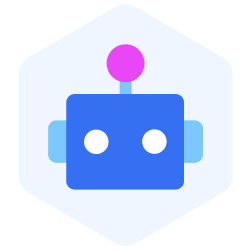What Are AI Agents? What You Need to Know

What Are AI Agents? What You Need to Know
 AI.png
AI.png
What Are AI Agents?
AI Agents are autonomous implementations of artificial intelligence. They can be virtual entities (such as programs, chatbots, or virtual assistants) or physical entities (such as robots). An AI agent senses its environment, evaluates its inputs against its instructions, and makes independent decisions.
How Do AI Agents Work?
AI agents interact with their environment to accomplish specific tasks. They follow algorithms and models that guide them in perceiving their surroundings, reasoning about their observations, making decisions, and taking action.
Agents consist of three primary components:
- Sensor: Collects data from the environment, ranging from simple temperature readings to complex data streams like video feeds or databases.
- Actuator: Takes actions to affect the environment.
- Processor: Contains algorithms and models for reasoning and decision-making.
When AI agents approach a task, they usually follow these steps:
- Perception: The agent gathers data from its sensors, which can be anything from a basic temperature reading to complex data streams (like video feeds, data files, or database tables).
- Processing: The agent processes the data using various algorithms. These algorithms can be simple, like comparing the current temperature to a setpoint, or complex, such as using machine learning algorithms to interpret sensor data or analyze language.
- Decision Making: Based on the processing results, the agent decides on an action to take. The decision-making process can involve rules or more advanced methods like decision trees, neural networks, or reinforcement learning models.
- Action: The agent uses its actuators to perform the chosen action, directly affecting the environment.
- Learning: Some agents can learn from the consequences of their actions. This is particularly true for agents using machine learning algorithms. Learning enables the agent to improve its performance over time by adapting to new information and experiences.
Types of AI Agents
There are five common types of AI agents, classified below based on how they modify or act upon the environment. The type of AI agent is, therefore, a measure of its intelligence and capacity.
Simple reflex agent This type of agent takes immediate actions based solely on the current state of the environment without considering past states.. If a condition holds true, the agent takes action. Otherwise, the agent will do nothing. This type of AI agent has limited intelligence.
Model-based reflex agent Similar to a simple reflex agent, this one also considers the environment's history. It considers past states when making decisions, providing a higher level of intelligence.
Goal-based agent These agents focus on achieving specific goals, replacing condition-action rules with goal-oriented objectives. They incorporate planning and search to determine the best course of action, considering past and present environmental states.
Utility-based agent A utility-based agent makes decisions based on the concept of utility. Utility refers to the measure of the desirability of different outcomes. This approach is valuable in fields like economics and robotics, where complex trade-offs and individual preferences play a role.
Learning agent Learning agents stand out by their ability to adapt and improve over time. They comprise four components: observing the environment, learning from experiences, executing actions, and formulating and solving problems. This adaptability sets them apart from other agent types.
AI Agent Use Cases
AI agents tend to be virtual entities working independently without human interference. They specialize in the automation of tasks and continuous decision-making. Plenty of applications in AI-enabled devices require such characteristics, such as driverless cars, robotics, video games, and virtual assistants like Alexa, Siri, Google Assistant, etc. In addition, AI agents can be used in data mining, data analytics, customer service and support, etc. With the introduction of LLMs like ChatGPT, everyone has become accustomed to the ritual of inputting prompts and receiving responses from AI models. Whenever you want something from the LLM, you enter your request (prompt), and out pops the answer, essay, email, or whatever you requested as the result of your prompt. Do this enough times, and you will realize that it would be nice to automate these tasks. In the realm of LLMs, several AI Agents emerged that can automate tasks such as answering questions, generating text, and translating or summarizing text. All you need to do is provide a sequence of tasks for the AI Agent to execute.
AI Agent Examples
Here are a few well-known examples of AI Agents and agent tools.
Auto-GPT
Auto-GPT is an autonomous AI Agent that employs the GPT-4 API to act autonomously. It’s implemented in Python and performs tasks with little or no human intervention. It can also self-prompt. It has long and short-term memory and can use persistent storage to record its history.
BabyAGI
BabyAGI is an AI platform for training and evaluating AI agents using GPT-4, LangChain, the OpenAI API, and vector database storage. It uses natural language processing (NLP) to evaluate task results and generate news ones to test agents in an infinite loop. In addition to generating new tasks, it can also implement prioritization in order to maximize resource utilization.
OSSChat
OSSChat is open-source chatbot software that facilitates the sharing and access of knowledge, code, and best practices for communities and developers. It integrates ChatGPT with documentation, issues, blog posts, and community Q&A. This makes it a comprehensive knowledge base for developers. It offers various features such as searching for answers, asking for guidance, collaborating with peers, and nominating favorite projects. OSS Chat provides state-of-the-art technology for chatbots.
AgentGPT
AgentGPT is an AI tool developed by OpenAI. It’s designed for creating, configuring, and deploying autonomous AI agents in a browser or personal computer. AgentGPT does not require continuous user input. Users specify their objectives and the agents work autonomously to achieve those goals.
SuperAGI
SuperAGI is an open-source autonomous AI agent framework that enables the development and deployment of useful autonomous AI agents quickly and dependably. Developers can create ready-to-produce, scalable, and optimized AI agents. It's possible to integrate various tools and toolkits as well as enhance the capabilities and performance of AI agents. Designed to run multiple AI agents synchronously, it is continuously improving and updating.
LlamaIndex
LlamaIndex is a data framework tailored for Large Language Models (LLM) applications, facilitating the ingestion, structuring, and access of private or domain-specific data. LlamaIndex includes Data Agents that are LLM-powered knowledge workers that can perform various read or write tasks over your data,
LangChain
LangChain is a framework for developing language model-powered applications, offering a range of valuable capabilities. With LangChain, you can utilize agents that automate tasks by chaining them together, generating prompts, responding using language model models (LLMs), retrieving documents, and much more.
- What Are AI Agents?
- How Do AI Agents Work?
- Types of AI Agents
- AI Agent Use Cases
- AI Agent Examples
Content
Start Free, Scale Easily
Try the fully-managed vector database built for your GenAI applications.
Try Zilliz Cloud for Free